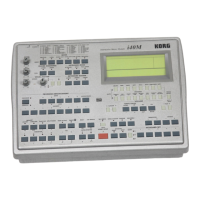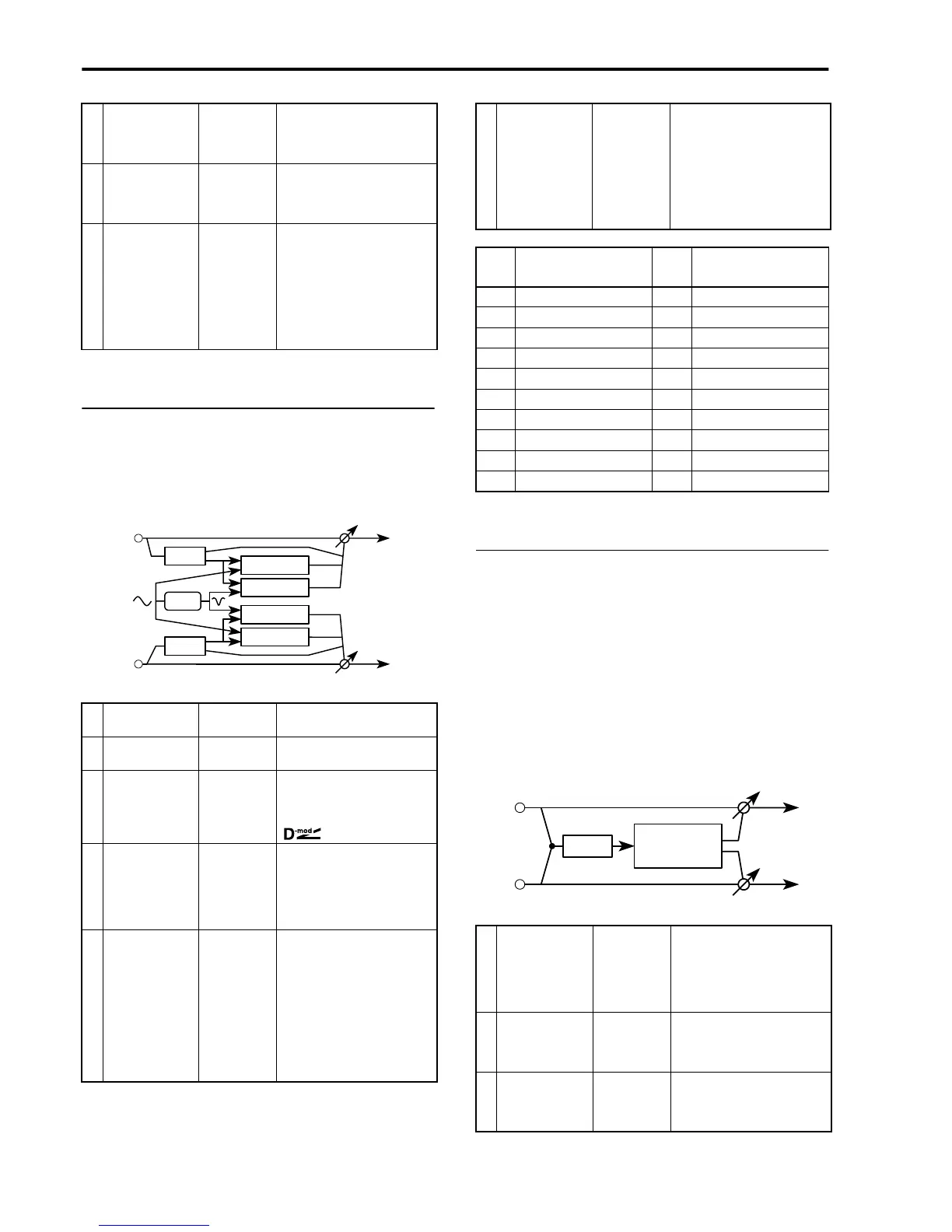Reference • Effects
184
23: Harmonic Chorus
23: Harmonic Cho. is a type of quadrature chorus in
which a filter is used to divide the input signal into
low and high frequency ranges, and two chorus sys-
tems are applied only to the high frequency range. It is
effective on low frequency range sounds such as bass.
24: Symphonic Ensemble
The Symphonic Ensemble effect is essentially identical
to the chorus type effects discussed earlier, but is espe-
cially effective when used on large-scale ensembles
such as orchestral strings.
24: Symphonic Ens. mixes the left and right channel
signals before applying the ensemble effect. The signal
processed by the effect will be output equally from
both channels.
A two-band shelving equalizer is applied to the sound
of the left and right channels before the ensemble
effect is applied.
L Equalizer low –12 dB…+12
dB
Set the amount of boost or cut
that the shelving type equalizer
will apply to the region below 1
kHz.
H Equalizer high –12 dB…+12
dB
Set the amount of boost or cut
that the shelving type equalizer
will apply to the region above 1
kHz.
Dry:Effect balance DRY,
99:1…1:99,
FX
Set the balance between the
direct sound (DRY) and the
sound processed by the effect
(FX). With a setting of DRY, the
effect will be turned off. With a
setting of FX, only the chorus
sound will be heard. Other set-
tings set the proportion of the
direct sound and effect sound.
A Delay time A 0…500 ms Set the basic delay length for
chorus unit A.
B Delay time B 0…500 ms Set the basic delay length for
chorus unit B.
→
S
Modulation speed 1…99 Set the speed of the LFO that
modulates the delay. Higher
values will produce faster modu-
lation.
☞P. 178.
M Modulation depth 0…99 Set the depth at which the LFO
will modulate the delay time.
Higher settings will cause the
modulation effect to be more
pronounced. With a setting of 0
there will be no chorus effect.
S
P
Filter split point 0…18 Specify the frequency at which
the filter will divide the input
signal into high and low fre-
quency ranges. Higher settings
will raise the split point fre-
quency. The chorus effect will
apply only to the portion above
this frequency. The table below
shows the correspondence
between this parameter value
and the actual frequency.
Left
Split
Chorus B
Right
Mix
Mix
Chorus A
Mod
Split
HF
LF
LF
HF
Chorus A
Chorus B
Dry:Effect balance DRY,
B1…B99, FX
Set the balance between the
direct sound (DRY) and the
sound processed by the effect
(FX). With a setting of DRY, the
effect will be turned off. With a
setting of FX, only the chorus
sound will be heard. Other set-
tings set the proportion of the
direct sound and effect sound.
Valu
e
Frequency
Valu
e
Frequency
0 160 Hz 10 1.60 kHz
1 200 Hz 11 2.00 kHz
2 250 Hz 12 2.50 kHz
3 320 Hz 13 3.20 kHz
4 400 Hz 14 4.00 kHz
5 500 Hz 15 5.00 kHz
6 640 Hz 16 6.40 kHz
7 800 Hz 17 8.00 kHz
8 1.00 kHz 18 10.0 kHz
9 1.25 kHz
M Modulation depth 0…99 Set the depth at which the LFO
will modulate the delay time.
Higher settings will cause the
modulation effect to be more
pronounced. With a setting of 0
there will be no ensemble effect.
L Equalizer low –12 dB…+12
dB
Set the amount of boost or cut
that the shelving type equalizer
will apply to the region below 1
kHz.
H Equalizer high –12 dB…+12
dB
Set the amount of boost or cut
that the shelving type equalizer
will apply to the region above 1
kHz.
Left
Symphonic
Ensemble
Right
Mix
Mix
EQ

